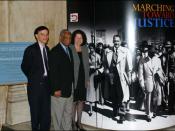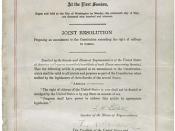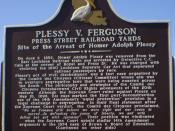Discrimination has long been prevalent in American society. The constitution itself is written by white-males for the intended purpose of governing white males, yet its application governs "the melting pot;" a plethora of individualistic differences all combined to create America itself. Virtually all others opposite, in any way different from a white male, even by a fraction (three-fifths, one-eighth, or one-sixteenth) of difference, have at one time or the other been discriminated against by white males. But the most egregious acts of discrimination, in their duration and by the sheer multitude of people that have been discriminated against, undoubtedly have been against African Americans. The Thirteenth Amendment abolishes slavery, and the Fourteenth Amendment makes them citizens, but they do not knock down the socially and legally constructed racial barriers, which last until 1954 when they begin to start crumbling away. Plessy v. Ferguson (1896) and Brown v. Board of Education (1954) are both major turning points in their civil rights issues, as well as their history and ramifications.
Both have had a lasting significance on American law and politics.
The ruling in Brown is directly related to the ruling in Plessy v. Ferguson (1896). Although segregation and discrimination were commonplace during that era, the ruling of Plessy is significant because after the ruling, it becomes condoned by American law. Plessy was virtually a white man, but he was one-eight black, and therefore was viewed as a black man by white America. He had attempted to sit in a train car in a designated "whites only" car, and upon his discovery, he was ordered by railway authorities to sit in a different car, along with people of his own race. Upon his refusal, he was thrown out, and placed in jail. But, this presented Plessy with a chance to challenge the...


